
The hair band style of music made popular in the 1980s generally requires guitars called super-Strats. These are guitars shaped like Fender Stratocasters that have been hot-rodded in any number of interesting ways. Usually they include at least one humbucking pickup in the bridge position, and are often adorned with neon colors or flashy designs. You have to remember that in the 70s, most rock bands played either Gibson Les Pauls, Fender Stratocasters or Telecasters. These hot-rodded super-Strats were a statement that the same old boring thing wasn’t good enough for us. Of course today, those “same old boring” Les Pauls, Strats and Teles from the 50s and 60s are worth a pretty penny, but back then, it was all about the look on these shredder guitars.

Even though I lived through the 80s and played in hair metal bands, I never owned a super-Strat due to a lack of funds. The good ones by names like Jackson and Charvel weren’t inexpensive, and this 20-something just didn’t have the coin. A few years ago I decided to finally buy a Jackson. The local shops only had two: A US-made Jackson Soloist SL1, and an import Jackson SL2H. The US-made Jackson was a better guitar, but from what I could tell, it had no serial number and had been repainted, likely indicating that it had been stolen. There is a special circle in Hell for people who steal musical instruments, and there was no way I was going to be a part of another musician’s misery. I bought the import without another thought, though I did report my suspicions to the store manager.
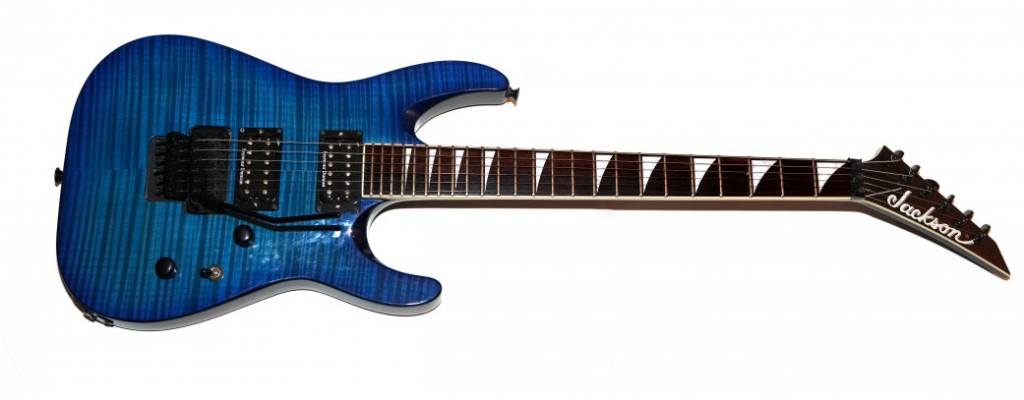
This particular imported Jackson SL2H was a limited edition made specially for Sam Ash. Purists will note that SL2H is a model designation for a particular USA Jackson Soloist model. Somehow the Sam Ash model also got to use this name. The guitar had many attributes of the US-made Soloists, but also had some important differences. First off, I loved the look. I’m a sucker for a blue flamed guitar, and this guitar had that in spades. The guitar had an arched top, with I also really liked and even had beveled cutaways which looked sexy as Hell to me. Arched tops and beveled cutaways are features usually only found on Jackson Custom Shop guitars with $3,000 price tags, so finding them on a $1,000 guitar was pretty cool.
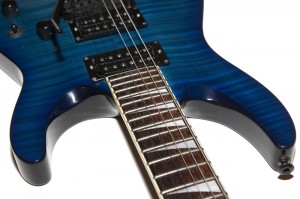
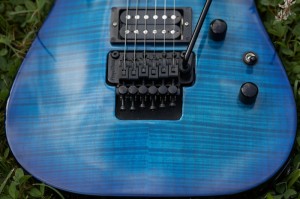
I imagine that the beautifully flamed top is a veneer on the import, but I can’t tell for sure. It certainly looks nice if it is. The pickups on the import are the same as the US models – a Seymour Duncan JB in the bridge position and a Seymour Duncan ’59 in the neck. The pickups sounded fine, but I have a philosophical problem with companies plastering their names on the bobbins of my pickups. So I pulled them and put in a set of WCR Ironmans. When I did this I cracked one of the pickup rings due to the fact that the import Jackson has plastic rings while the US Jackson Soloists have sexy metal rings.
All of those details are great, but how does it play? In my hands, this import Jackson is 90% the guitar that the US-made Jackson are. It plays great, sounds great, and performs as expected. I can do full-out slack-string dive bombs on the Floyd Rose, and I can pick the guitar up by the bar, though I’ve never made a habit of doing so.
I own a lot of nice guitars and this import Jackson has been my go-to guitar since I bought it. The neck is the best neck I’ve ever felt, the jumbo frets are slinky and smooth, and it just feels perfect in my hands. Best of all, it was less than half the price of a US-made Jackson SL2H at the time of purchase. If I had to list things I didn’t like about the guitar, the plastic inlays are distracting on the lower frets, and they’re not as meticulously installed as I’d like. Otherwise I’ve been very pleased with the guitar.

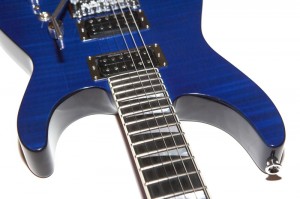
Most of the differences between the guitars are pretty obvious. On the USA Jackson Soloist SL2H, the cutaways are not beveled, and the hardware is composed of high quality silver components. The pickup rings appear to be metal. The top of this guitar is flat, and this guitar has a forearm contour on the upper bout. The import does not have this contour, but since it’s an archtop, I don’t think it needs one — I certainly never noticed its absence. The fretboard on the US Jackson is ebony with real mother-of-pearl inlays. This setup is much nicer to the touch than the plastic inlays on the import’s rosewood fretboard. The attention to detail on the USA inlay installation is evident as well. One difference that surprised me was the material used to make the back plates covering the control and spring cavities. On every guitar I’ve ever owned, these plates are plastic, or the same material as a standard pick guard. The covers on the USA Jackson Soloist are metal.
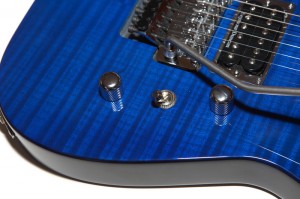
One thing that I really like about the Jackson Soloists is the neck joint. Both guitars are neck-thru designs which means that the neck isn’t just glued onto the body of the guitar like a Les Paul. Instead, the neck of these Jacksons continues all the way through the guitar. Because of this, the position on the neck that would normally be called the joint has a smooth contour that feels absolutely wonderful in the hand. This slick neck joint makes upper fret access a breeze and adds a feeling of slippery sexiness to the guitar.
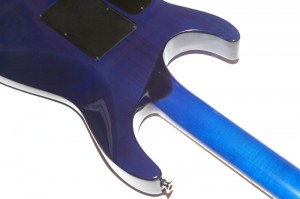
When playing each of these guitars, the differences in feel are subtle to my hands, with one noticeable exception. Due to the difference between an arched top and a flat top, and the fact that I played the arch top for years, the bridge doesn’t feel like it’s in the right place when I palm mute the stings on the flat top. The arched top on the import is nice, but aside from the palm muting thing, it’s not as significant difference in feel as I expected it to be. The ebony board feels much nicer, but the frets are so large on these guitars that if you’re squeezing hard enough to feel the fretboard, then you’re probably pulling the strings out of tune. Still, there is something about the USA Jackson that makes it feel more like a quality guitar. It feels like a guitar that costs twice as much as the import. I’m not sure why, and it’s entirely possible that this feeling is psychological. The import is no slouch though. Though it cost about the same as my 2008 American Deluxe Fender Strat, the import Jackson feels like a superior instrument in my hands.
Feel and looks aside, I think the USA Jackson Soloist will stand the test of time better than the import will. With its plastic parts and cheaper Floyd, I anticipate that the import guitar will show signs of wear much sooner than its US-born brethren. I’ve already broken a pickup ring, though to be fair, I’ve owned the import Jackson much longer than I have the US Jackson.
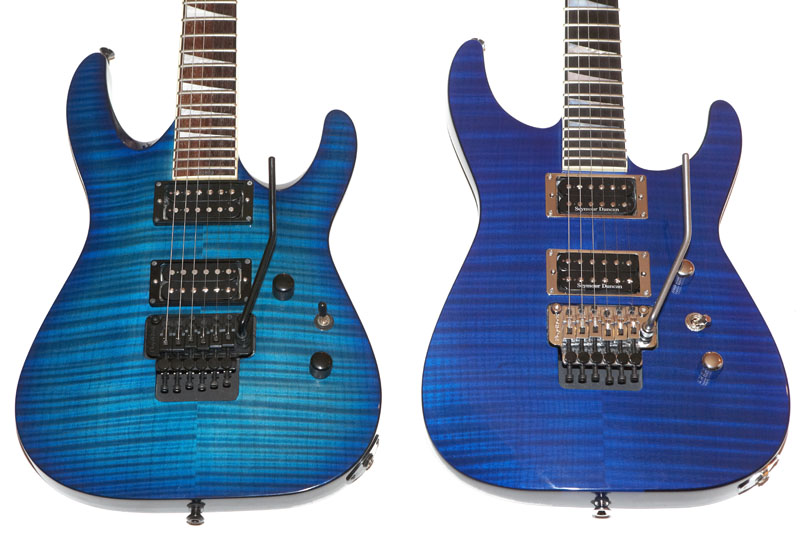
So given the choice, which one would I buy today? Well, they don’t make this particular Sam Ash special version anymore, but the question might be more relevant today comparing say a USA Jackson Soloist SL1 to the almost identical, but imported, Jackson Soloist SL3. I would have to say that it would really come down to available funds. If you can afford the USA Jackson Soloist, definately get it — it’s a better guitar. That said, if you only have enough money to get the import, don’t feel too bad about it. These import Jacksons are serious guitars that will impress all but the most dedicated of cork sniffing gear snobs. If you need a guitar that will stand up to the abuse of gigging in your ’80s cover band, I’d probably advise you to save up and get the US-made Jackson. Real value can be found buying USA Jackson Soloists on the used market.
Donate: PayPal Crypto:
ETH: 0x0AC57f8e0A49dc06Ed4f7926d169342ec4FCd461
Doge: DFWpLqMr6QF67t4wRzvTtNd8UDwjGTQBGs

Thanks for writing this, I found it interesting.
This brought me straight back to my head-bangin’ glory metal heydays.
What a informative blog!! I just bought a Sam Ash exclusive SL2H. When I test drove the Jackson I loved it.I assumed it was made on USA, it didn’t say made I’m usa on it. Wikipedia states that all SL2H are USA made. I even called Jackson guitar company and gave them the serial number, just to get confirmation. And they told me it checked out as a usa-made guitar and they did mention it was a Sam ash exclusive. I thought I was getting a good deal, come to find out I was overcharged. I have 30 days to return. Thank you so much providing accurate information that even manufacturer couldn’t produce!
Depends on what you paid. I’ve owned two of these and paid about $800 for each. They are far better than most imports IMO and the neck joint with arched top alone makes them great guitars. I recently bought a ’91 Soloist Profession Pro which is basically the same design but made to the US guitar specs and it is *magnificent*. It cost me $1100 but they’re super hard to find, though.